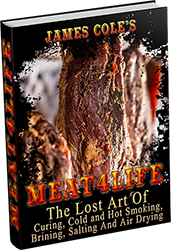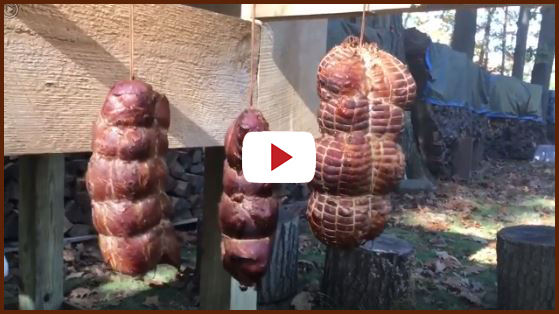Before refrigeration people relied on salt and smoke to preserve their meat. Most people lived on family farms and the “smoke house” was as familiar as the outhouse. Refrigeration changed the way we did a lot of things, but one thing it did not change was our taste for the flavor of smoked meat.
Consequently, smokers are readily available today and recipes abound, including those for smoking your meat in your backyard grill. But one thing that nearly all of these recipes have in common is: the meat is cooked and so the end product will require refrigeration.
Meat Preservation:The Lost Ways Of Curing And Smoking
To preserve meat that will not require refrigeration a process known as Hard Smoking is required. Hard smoked meat is similar to jerky. It contains a lot of salt, and it is smoked at a low temperature until there is very little moisture left in it. It is kind of like the dehydration method used for fruits and vegetables, but done with smoke and the addition of salt and usually other spices as well. The salt helps preserve the meat by inhibiting the growth of microorganisms. Sometimes the meat is so salty that you may even want to soak it for a few hours before eating it to remove some of the salt. (People used to save this water and reclaim the salt by allowing the water to evaporate.)
The smoked meats and jerky that you buy in stores today contain preservatives called nitrites, so their moisture content may be slightly higher and their salt content slightly lower. Their recommended shelf-life is one year. Nitrites are known to cause cancer so their consumption should be limited. The jerky that you make at home, if preserved properly, should keep indefinitely even without nitrites, but as with any preserved food its quality will deteriorate over time. It would best be best to consume it within six months to a year.
Spices have been highly prized over the centuries, with certain spices at times being worth more than their weight in gold. You might recall, from your American history class, that when Christopher Columbus discovered the New World he was actually looking for a shorter trade with India, primarily for spices. We enjoy spices because they impart interesting flavors to our foods. But before the days of refrigeration they were also highly valued for their ability to preserve food. By using certain spices that have strong antimicrobial actions, we can reduce the amount of salt needed to preserve our meat, making it more palatable and healthier at the same time.
Spices with antimicrobial action include garlic, ginger, black pepper, clove, oregano, thyme, nutmeg, cinnamon, allspice, bay leaves, mustard, rosemary, bishop’s weed, chilli (also called cayenne or red pepper), horseradish, cumin, black cumin, pomegranate seeds, onion, celery, geranium and many others. Some spices by themselves have weak antimicrobial effects that become much stronger when combined with other spices. (These combinations are said to be synergistic, because the combination is greater than the sum of the individual parts.) Chili powder is a synergistic combination typically consisting of red pepper (cayenne), onion, paprika, garlic, cumin and oregano. Five-spice powder is a synergistic combination of pepper, cinnamon, anise, fennel and cloves. Most people think that the combination of spices known as curry powder originated in India. But curry is actually a Western blend devised during colonial times combining the best spices from India. Curry powder recipes vary slightly, but turmeric is always a key ingredient in the blend. The usual recipe for curry powder in the West consists of turmeric, cardamom, cumin, fenugreek and chilles. Other herbs that are commonly included in curry blends include ginger, garlic, coriander, cloves, nutmeg, mustard, black pepper, fennel, and others.
We can extend the shelf-life of our homemade jerky with the judicious use of spices. Salt and pepper, either black or red, are key ingredients. The other spices that I prefer include garlic, ginger, and turmeric. I also like the spice blends mentioned above, curry powder, chili powder and five-spice powder. If a liquid marinade is to be employed soy sauce may be used as the source of salt.
Safety Precautions
Jerky is considered a very safe and effective method of preserving meat. However, over the years a few incidents of food poisoning have been reported as a result of improperly cured jerky. This can be easily avoided if a few commonsense precautions are followed:
1) Cleanliness is rule number one. It begins in the field when the animal is field dressed or gutted. Try to keep the meat from coming into contact with the contents of the intestines. Rinse the inside of the animal thoroughly with water if possible.
2) Before preparing any food wash your hands thoroughly using soap and water. Use a mild chlorine bleach solution (one tablespoon of bleach to a gallon of water) to clean all surfaces and materials that will come into contact with the meat. (By now it should be evident that chlorine bleach is an important survival item that should be stored in sufficient quantities.)
3) The use an oven thermometer to insure that your smoker/dryer maintains the proper temperature is recommended.
4) Jerky must be completely dry, since bacteria require moisture to grow. Properly dried jerky should crack when bent in half, but not necessarily break into two pieces. Allow the jerky to cool to room temperature before testing.
5) Avoid Cross-Contamination by not allowing your finished product to come into contact with surfaces that have been contaminated by raw meat
6) Store jerky in airtight jars or plastic bags to prevent it from absorbing moisture and bacteria from the air. Allow the jerky to cool to room temperature before placing it into airtight containers.
7) If moisture appears on the inside of the storage container the jerky is not dry enough. Dry it longer.
Learn how the Native Americans preserved their meat in this video !
Drying/Smoking Temperatures
There are a lot of opinions regarding ideal drying/smoking temperatures. Some differences of opinion are the result of safety concerns, and some have to do with what you intend to do with the meat. Those who plan on storing their dried meats in a refrigerator or freezer tend to cook their meat as well as dry it. It is important to remember that cooked meat is not suitable for long term storage and must be stored in a refrigerator or freezer or else eaten within a few days. When properly cured and dried, without cooking, meat will keep indefinitely, (although its quality will begin to deteriorate after a few months so it should probably be eaten within a year.)
Because of the natural preservative nature of smoke, smoking meat can be safely done at a lower temperature than that used when drying meat without smoke. Also, meat properly cured with salt and spices can be safely dried or smoked at a lower temperature. In general, I believe that it is best to use the lower temperatures, by using the smoking process rather than drying alone, and being sure to cure the meat with salt and spices beforehand.
 The USDA recommends drying/smoking temperatures of 145o F for 7 hours or 155o for 4 hours. Care should be taken not to exceed 155o F or the meat will get cooked rather than dried. Lower drying temperatures of 125o F for 10 hours or 135o F for 8 hours are recommended by some, and I have even seen recommendations as low as 95o to 130o F.
The USDA recommends drying/smoking temperatures of 145o F for 7 hours or 155o for 4 hours. Care should be taken not to exceed 155o F or the meat will get cooked rather than dried. Lower drying temperatures of 125o F for 10 hours or 135o F for 8 hours are recommended by some, and I have even seen recommendations as low as 95o to 130o F.
I recommend that you begin the drying process at a lower temperature, say around 125o F, and then gradually increase it each hour until the maximum temperature of 145o to 150o F is reached for the final hour or so. This will insure that the meat is thoroughly dried through and through without getting cooked. Check the meat for doneness by allowing a piece to cool down and then bend it.
To convert degrees Fahrenheit to Celsius subtract 32, then multiply by five and divide by 9. Or use the following approximations:
|
F
|
C
|
|
95
|
35
|
|
100
|
38
|
|
105
|
41
|
|
110
|
43
|
|
115
|
46
|
|
120
|
49
|
|
125
|
52
|
|
130
|
54
|
|
135
|
57
|
|
140
|
60
|
|
145
|
63
|
|
150
|
66
|
|
155
|
68
|
The Drying/Smoking Process
Smoking the meat is not an absolute necessity, but in my opinion it is highly desirable—not only because the smoke imparts a nice flavor to the meat, but more importantly because the smoke is a natural preservative. Jerky can be made in an ordinary oven by leaving the oven door open slightly to allow the moisture to escape. It is important that the temperature does not exceed 155o F because you want to dry the meat rather than cook it. Cooked meat is not preserved. You should set an oven thermometer on the oven rack toward the back to monitor the heat. Obviously this is best done in the cold months of the year when the heat escaping from the oven can be used to help keep your house warm, rather than increasing your air conditioning bill.
Drying jerky can also be done in a food dehydrator. Again a thermometer may be advisable to monitor the heat. Even if your dehydrator has a temperature setting, these are often inaccurate. A solar dehydrator is also an option. The Native Americans (who taught the European settlers about jerky in the first place) used to dry their meat in the open air and sun. In some cultures the meat is actually hung in the sun on the thorns of shrubs. So, despite all of these seemingly complicated instructions, never forget that making jerky is not rocket science!
As I have mentioned my favorite way to make jerky is in a smoker, using the natural preservative nature of the smoke to help preserve the meat. Ordinarily smokers contain a pan of water, which helps keep the meat moist. However, the end product of most smoking recipes will require refrigeration. Our intention is to use the hard smoking process to make jerky, with a very low moisture content, that will keep indefinitely without refrigeration. So skip the water! I also recommended that you monitor the temperature, keeping it below 155o F, so that your meat will be dried rather than cooked. Many commercial smokers are available, using gas, charcoal or wood. They can also be easily made using inexpensive materials.
The recipes and directions that come with most smokers, like the one pictured above, will result in the meat being cooked rather than hard smoked. The end product will require refrigeration. Our intention is to make jerky that will not require refrigeration, so we want to use the hard smoking process which is accomplished by using smoke at a lower temperature.
I have seen a very effective homemade smoker made by a deer hunter. He used his smoker to process his entire deer into jerky in a matter of a couple of days. It consisted of a large wooden box with screened shelves that would slide out. (If you make your own smoker or dryer don’t use metal screens. They are galvanized with zinc which is not suitable for contact with food.) He would dig a fire pit about 6 feet from the smoker. On top of the pit he put a 6 foot length of 6 inch galvanized vent pipe (the kind you use to vent your furnace) on a slight incline leading from the fire pit to a hole in the lower side of the smoke box. He would start a fire in the fire pit and then cover it with a piece of sheet metal to keep the fire smoldering and to direct the smoke through the vent pipe and into the smoke box.
Another ingenious method suitable for the cold months of the year makes use of a wood burning stove in your house, with the stove pipe running to the outside of your house and into your smoker. Since smoke rises, the smoker must be at a higher level than your stove. Sufficient stove pipe should be used to insure that the smoke cools enough before entering the smoker, otherwise the meat could get cooked rather than dried. A heat reclaimer on the stove pipe inside the house can also increase the efficiency of such a unit, further reclaiming the heat for the house and cooling down the smoke sufficiently for the smoker at the same time. This is the procedure that I use (illustrated in the photograph above) using a wood stove in my basement with the stove pipe running through a basement window and into my smoker on the outside. Needless to say great care should be taken to avoid setting your house on fire. Never leave such a unit unattended!
There is a variety of opinions regarding the best wood to burn in your smoker. I don’t think it matters a lot, so use what you have available. Any hardwoods will do. Fruit trees like apple will do very nicely. When I prune my fruit trees I save the trimmings to use for my smoker. I have never used pine but I have heard others say that it should be avoided.
Making Jerky
Select the leanest cuts of meat for making jerky and remove all visible fat. Fat does not preserve well and can adversely affect the taste and quality of your jerky. For a product that does not require refrigeration you are going to want to remove as much moisture from the meat as possible. This can be accomplished more easily by slicing the meat very thin. Slice the meat across the grain (at a right angle to long muscles) for the most tender jerky, or with the grain for a more chewy jerky. Cut it into strips no more than a quarter of an inch (6 mm) thick. This is more easily accomplished if the meat is slightly frozen.
Basic Brine recipe: Two cups of salt, 1 cup of sugar, 1 tsp. ground black pepper, 1/2 tsp. ground cloves, 1/2 tsp. of garlic powder and 1/2 tsp. of turmeric powder. Other herbs and spices may be used according to availability and tastes. The only ingredient that is absolutely essential is the salt. To make a liquid for cold marinating or for a boiling marinade add this dry mixture to 2 quarts of water. The mixture can be made slightly weaker (more water) for a boiling marinade. For a dry marinade mix the dry ingredients without any liquids.
Cold Marinade
Soak the strips of meat in the marinade in a refrigerator overnight, or for at least three hours. This is most easily done in a plastic bag. At least once during the marinating process shake the bag and turn it over to insure that all the meat comes into contact with the marinade. After the meat has been marinated, remove it from the marinade, shake off the excess and put it in the dryer or smoker. Some people are concerned about bacterial growth in the cold marinade. Certainly this step should be done in the refrigerator. If refrigeration is not available, alternative methods include boiling marinade and dry marinade.
Boiling Marinade
As an extra precaution, the USDA recommends that meat be precooked to at least 160o F before drying. This is accomplished by skipping the cold marinade, and instead, the raw meat is dipped into a boiling marinade until the it turns gray (one to two minutes.) Then it is dried or smoked as usual. Care should be taken not to cook the meat too much. No other marinating is necessary because the heat causes the marinade to penetrate the meat very rapidly. I don’t think that such a precooking step is necessary, but a boiling marinade may be a desirable alternative if your refrigerator is not working. I prefer the following dry marinating process instead.
Dry marinade
During a prolonged emergency the dry marinating process may be the best choice, not only because it requires less energy, but also because it makes the most economical use of your marinade. The dry marinade is mixed well and sprinkled generously onto a large cutting board. The strips of meat are laid on the dry marinade, first one side and then the other, to coat both sides well. Then a wooden mallet is used to pound the marinade into the meat. If your refrigerator is working, or if it is very cold outdoors, the strips can be stacked one upon the other, put in a plastic bag or closed container, and put in the cold for a few hours or overnight to allow the dry marinade to soak into the meat. This step is not necessary, since you have pounded the marinade into the meat with the wooden hammer, so if the temperature is warm it may be best to immediately shake off the excess marinade and put the strips in the smoker or dryer.
Want to be as self-sufficient as possible? Want to master all the lost skills our grandfathers had? Then you really need this amazing step-by-step guide. It is called The Lost Ways and it contains all the knowledge of our forefathers.
Here’s just a glimpse of what you’ll find in The Lost Ways:
From Ruff Simons, an old west history expert and former deputy, you’ll learn the techniques and methods used by the wise sheriffs from the frontiers to defend an entire village despite being outnumbered and outgunned by gangs of robbers and bandits, and how you can use their wisdom to defend your home against looters when you’ll be surrounded.
Native American ERIK BAINBRIDGE – who took part in the reconstruction of the native village of Kule Loklo in California, will show you how Native Americans build the subterranean roundhouse, an underground house that today will serve you as a storm shelter, a perfectly camouflaged hideout, or a bunker. It can easily shelter three to four families, so how will you feel if, when all hell breaks loose, you’ll be able to call all your loved ones and offer them guidance and shelter? Besides that, the subterranean roundhouse makes an awesome root cellar where you can keep all your food and water reserves year-round.
From Shannon Azares you’ll learn how sailors from the XVII century preserved water in their ships for months on end, even years and how you can use this method to preserve clean water for your family cost-free.
Mike Searson – who is a Firearm and Old West history expert – will show you what to do when there is no more ammo to be had, how people who wandered the West managed to hunt eight deer with six bullets, and why their supply of ammo never ran out. Remember the panic buying in the first half of 2013? That was nothing compared to what’s going to precede the collapse.
From Susan Morrow, an ex-science teacher and chemist, you’ll master “The Art of Poultice.” She says, “If you really explore the ingredients from which our forefathers made poultices, you’ll be totally surprised by the similarities with modern medicines.” Well…how would you feel in a crisis to be the only one from the group knowledgeable about this lost skill? When there are no more antibiotics, people will turn to you to save their ill children’s lives.
And believe it or not, this is not all…
Table Of Contents:
Making Your Own Beverages: Beer to Stronger Stuff
Ginger Beer: Making Soda the Old Fashioned Way
How North American Indians and Early Pioneers Made Pemmican
Spycraft: Military Correspondence During The 1700’s to 1900’s
Wild West Guns for SHTF and a Guide to Rolling Your Own Ammo
How Our Forefathers Built Their Sawmills, Grain Mills,and Stamping Mills
How Our Ancestors Made Herbal Poultice to Heal Their Wounds
What Our Ancestors Were Foraging For? or How to Wildcraft Your Table
How Our Ancestors Navigated Without Using a GPS System
How Our Forefathers Made Knives
How Our Forefathers Made Snow shoes for Survival
How North California Native Americans Built Their Semi-subterranean Roundhouses
Our Ancestors’Guide to Root Cellars
Good Old Fashioned Cooking on an Open Flame
Learning from Our Ancestors How to Preserve Water
Learning from Our Ancestors How to Take Care of Our Hygiene When There Isn’t Anything to Buy
How and Why I Prefer to Make Soap with Modern Ingredients
Temporarily Installing a Wood-Burning Stove during Emergencies
Making Traditional and Survival Bark Bread…….
Trapping in Winter for Beaver and Muskrat Just like Our Forefathers Did
How to Make a Smokehouse and Smoke Fish
Survival Lessons From The Donner Party
Get your paperback copy HERE
CHECK OUR survival and prepping solutions
If you found this article useful, please like our Facebook page and stay up to date with the latest articles.
WHAT TO READ NEXT:
HOW TO MAKE YOUR OWN BACON (STEP BY STEP GUIDE)
A RETURN TO THE OLD PATHS: HOW TO MAKE PEMMICAN LIKE THE NATIVE AMERICANS
20 LOST RECIPES FROM THE PIONEERS: WHAT THEY COOKED ON THEIR JOURNEY WESTWARD
SEVEN CLASSIC GREAT DEPRESSION ERA RECIPES GRANDMA USED TO MAKE
POTTED MEAT: A LOST SKILL OF LONG TERM MEAT STORAGE
BACK TO BASICS: HOW TO MAKE AND PRESERVE LARD
THE BEST WAY TO STOCKPILE VEGETABLES OFF-GRID
OLD FASHIONED PRESERVING-GRANDPA’S RECIPE FOR CURED SMOKED HAM
HOW TO MAKE GUNPOWDER THE OLD FASHIONED WAY
SURVIVAL HERBAL RECIPES FROM OUR ANCESTORS
HOW TO PRESERVE MEAT FOR SURVIVAL LIKE OUR GRANDFATHERS
OTHER USEFUL RESOURCES:
The 3 Pioneer Survival Lessons We Should Learn
The Most Effective Home Defense Strategies
Old School Hacks for Off-Grid Living
The Medical Emergency Crash Course



Hi I’m fro South Africa and biltong is our equivalent of Jerky. It is preserved in a total different way tan jerky. The meat is cut in lengths of up to 1 feet along the grain about 3/4 to on inch thick then salted on both sides an placed in a container with some vinegar and pepper, some people use coriander to but it is only a matter of taste, then it is left over knight and hanged to dry, in a room with ventilation with gauze to keep flies and insects away, it can also be cured in a wooden box with a ventilating fan. It is best to make biltong in the winter with cooler weather. Beef biltong don’t have to be completely dry it taste better with a soft center, on the other hand game biltong should be very dry, until it splinter when you bend it. Biltong can be stored in wooden boxes for as long as you want to